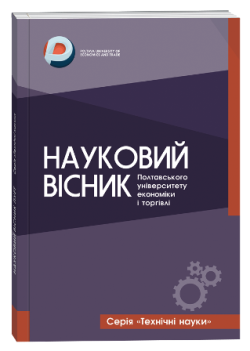PRODUCTS OF HENOMELES PROCESSING AS A COMPONENT OF THE COMBINED STRUCTURE FORMATION SYSTEM
Abstract
The research of the use of combined structure forming agents in gelatin and fruit additives with high functional and technological properties in dessert technology is a promising direction for expanding the range of sweet dishes with a gelatinous structure and contributes to the increase of their biological value. The article is devoted to the study of the use of henomeles processing products ( puree and gelling juice) as a component of combined structure formers in the technology of souffle dessert. The current state of the use of fruit additives in the technology of food products with a gelling structure is analyzed. Previous results have proved the effectiveness of using pectin-containing raw materials of plant origin as a structuring agent as a component of a combined gelling additive in the technology of dessert sweet dishes. The main aim of the article is to study the use of henomeles processing products as a component of a combined structure formation system in the technology of making souffles. The chemical composition of three varieties of henomeles fruits (Vitamin, Citrine and Orange) was studied. The quality indicators of puree from henomeles fruits and gelling juice from henomeles pomace were determined. It has been found that the selected varieties of henomeles and their processed products (mashed potatoes and gelling juice) are characterized by a significant content of biologically active substances, including pectin, phenolic substances and L-ascorbic acid. Henomeles recycled products are characterized by high acidity, which complicates their independent use in food technology, but proves the feasibility of using them as a fruit additive with high gelling properties. The results of the experimental studies confirm the feasibility of using the processed products of henomeles as a 50% replacement of gelatin in the recipe composition of the souffle dessert. New recipe compositions of soufflé using henomeles processing products have been developed. The organoleptic evaluation of the produced soufflé, its structural-mechanical, physicochemical and microbiological parameters were carried out. It has been established that the addition of puree and gelling juice from henomeles to the recipe of dessert products (soufflés) allows reducing the part of gelatin in their composition, increasing the biological value of the dessert, and the production of gelling juice from pomace also introduces the complex processing of henomeles fruits.
References
2. Kopanytsya, O. M., Hudyma, A. A., Myalyuk, O. P., Lisnyansʹka, N V., & Klishch, I. M. (2021). Osoblyvosti vykorystannya karahinaniv yak kharchovykh dobavok [Peculiarities of using carrageenans as food additives]. Bulletin of medical and biological research, (2), (pp. 113–119) [in Ukrainian].
3. Rudakova, T., Minorova, A., Krushelnytska, N., & Narizhnyy, S. (2021). Naukovi pidkhody shchodo klasyfikatsiyi molochnoyi desertnoyi produktsiyi [Scientific approaches to the classification of dairy dessert products]. Food resources, (9(16)), (pp. 164–179). https://doi.org/10.31073/foodresources2021-16-16. [in Ukrainian].
4. Nykyforov, R. P., Simakova, O. O., Slashcheva, A. V., Nazarenko, I. A., Popova, S. YU, Horyaynova, YU. A. (2020). Innovatsiyni tekhnolohiyi desertnoyi produktsiyi na osnovi bilkovo vuhlevodnoho napivfabrykatu [Innovative technologies of dessert products based on protein-carbohydrate semi-finished products]. Kryvyi Rih : DonNUET [in Ukrainian].
5. Sabadosh, H. O. (2016). Vplyv faktoriv na pinoutvorennya v tekhnolohiyi molochnykh desertiv z vykorystannyam karahinanu [The influence of factors on foaming in the technology of dairy desserts using carrageenan]. Bulletin of the National Technical University "Kharkiv Polytechnic Institute". Series: Innovative studies in scientific works of students. (29). (pp. 49–54). Retrieved from http://nbuv.gov.ua/UJRN/vcpiind_2016_29_10 [in Ukrainian].
6. Jonata M. Ueda, Mariana C. Pedrosa, Sandrina A Heleno, Márcio Carocho. (2022). Food Additives from Fruit and Vegetable By-Products and Bio-Residues: A Comprehensive Review Focused on Sustainability. Sustainability. (14), (5212). Retrieved from https://www.researchgate.net/publication/360225631_Food_Additives_from_Fruit_and_Vegetable_By-Products_and_Bio-Residues_A_Comprehensive_Review_Focused_on_Sustainability. [in English]
7. Yingdan Zhu, Yueting Luan, Yingnan Zhao, Jiali Liu, Zhangqun Duan and Roger Ruan, (2023). Current Technologies and Uses for Fruit and Vegetable Wastes in a Sustainable System. Foods. (12), (1949). Retrieved from https://www.mdpi.com/2304-8158/12/10/1949.
8. 8. Lebedynets, V.T., Havrylyshyn, V. V., Lebedynets, A. I. (2018). Obgruntuvannya retsepturnoho skladu keksiv z vykorystannyam produktiv pererobky ayvy zvychaynoyi ta khenomelesu [Justification of the recipe composition of cupcakes using quince and henomeles processing products]. Bulletin of LTEU. Technical sciences, (21), (pp. 73–77). Retrieved from https://www.lute.lviv.ua/fileadmin/www.lac.lviv.ua/data/DOI/2522-1221-2018-21-11.pdf [in Ukrainian].
9. Monika Bieniasz, Ewa Dziedzic, Elżbieta Kaczmarczyk. (2017). The effect of storage and processing on vitamin C content in Japanese quince fruit. Folia Hort. (29/1), (pp. 83–93). Retrieved from https://www.researchgate.net/publication/318156628_The_effect_of_storage_and_processing_on_Vitamin_C_content_in_Japanese_quince_fruit.
10. Ditrikh, I., & Lytvyn, YA. (2015). Ayva yaponsʹka yak inhrediyent plodovo-yahidnoho morozyva [Japanese quince as an ingredient of fruit and berry ice cream]. Goods and markets. (1), (pp. 106–112). Retrieved from http://nbuv.gov.ua/UJRN/tovary_2015_1_12. [in Ukrainian].
11. DSTU ISO 7218:2014 Mikrobiolohiya kharchovykh produktiv i kormiv dlya tvaryn. Zahalʹni nastanovy shchodo mikrobiolohichnykh doslidzhen [Microbiology of food products and animal feed. General guidelines for microbiological research] (ISO 7218:2007, ISO 7218:2007/Amd 1:2013, IDT) . [Effective from 2016– 06-01].
12. Levchenko, YU. V. (2017). Rozrobka tekhnolohiyi solodkykh sousiv z vykorystannyam khenomelesu [Development of the technology of sweet sauces using henomeles]. Extended abstract of PhD dissertation. Poltava [in Ukrainian].
13. DSTU 3718:2007. Kontsentraty kharchovi. Solodki stravy. Zhele, musy, pudynhy, kontsentraty molochni. Zahalʹni tekhnichni umovy [Food concentrates. Sweet dishes. Jelly, mousses, puddings, milk concentrates. General technical conditions] [Effective from 2009-01-01]. Kyiv. (Information and documentation). [in Ukrainian]


